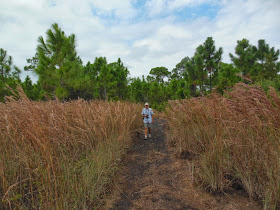The Ceraunus Blue (Hemiargus ceraunus) is a tiny (3/4 inch) member of the family Lycaenidae found in the southern half of North America.
Named in the eighteenth century by Danish zoologist, Johan Christian Fabricus....who specialized in all creatures "insecta," I wonder if this pretty little blue memorializes the seventh century Bishop of Paris, the saint of the same name? Or perhaps, Keraunus, eldest son of Ptolemy, and king of Macedon. But, I digress....and here is a likeness of JC Fabricus who gave us so many interesting binomials.
And just in case you, like me, wonder how to pronounce ceraunus,
here's a great link...
Resting with wings spread makes identification easy, but more often one will just see a flash of flying blue!
The Florida population of Ceraunus Blues have one submarginal eyespot on their hindwing. But, you have to get them to hold still and get close enough to see it!!
Females are more brown on the ventral side and the dorsal wing edges not as deep blue as the males.
This male shows really distinct blue dorsal wing edges. These photos were taken at the Land Base of Don Pedro State Park in Placida, Florida...a great place to visit, and a location where you are sure to spot some Mangrove Buckeyes!!
This is Florida's only other small blue butterfly,....the Cassius Blue (Leptotes cassius). Note the two submarginal eyespots! So, when you see a small blue in Florida....check out the eyespots...one for a Ceraunus and two for a Cassius.
Cassius, as we all know, was the Roman Senator who was the chief instigator of the plot to assassinate Julius Caesar. How cassius came to be part of this binomial I do not know....but credit goes to Pieter Cramer, Dutch entomologist, and the first to write a book using Carl Linnaeus' naming system and containing many fine scientific illustrations.
Always lots to see in "natural" Florida and lots to learn about our flora and fauna.
























